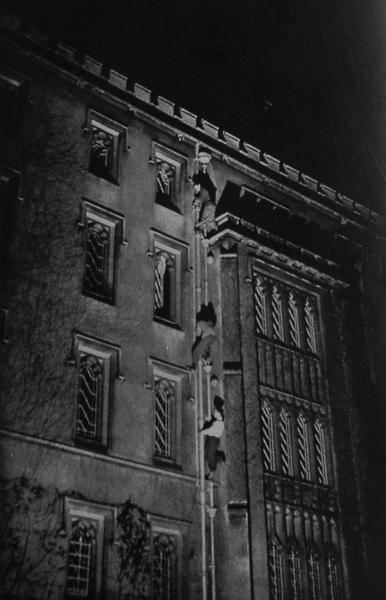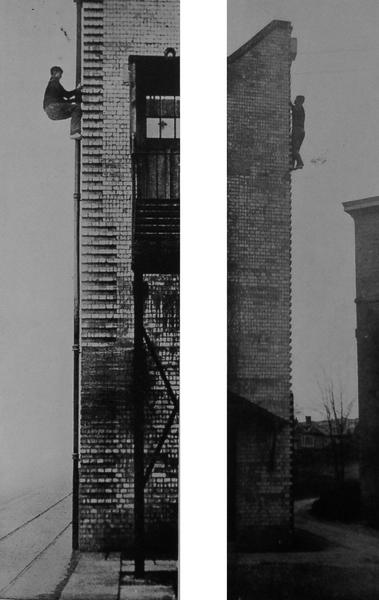Chapter 5. Drain-Pipes
"Very like a whale" | ||
| --Hamlet | ||
Cambridge climbing falls very largely into two categories: drain-pipe and chimney. Good climbs up stone faces can be found in plenty for those who want them, but every night climber should be able to climb a drain-pipe if necessary. The drain-pipe is the most urgent thing to be mastered by the beginner. With drain-pipe technique in his hands and knees, he will have the confidence to tackle any climb in Cambridge, for, in our opinion, it is the hardest part of the art to learn.
To those who are unfamiliar with drain-pipes, it might seem that one is as good as another. To the climber each pipe has its own individuality. It may be loose, or tightly clamped to the wall. It may touch the wall, or stand half an inch out so that there is finger-room behind. It may be as thin as a man's wrist or as thick as his thigh; the former is better for hand-grip, the latter for knee-grip. The surface of the wall may be smooth, or it may be rough, offering a certain amount of friction-hold for the feet. Sometimes the pipe is bound at .intervals with iron, sometimes not. It may go past window-ledges which serve as resting-places every fifteen feet, or it may be fixed to a bare wall. Sometimes it is in a corner, or better still, a foot or two away from a corner. It may be near a street light, or in a place where only the moon and the stars reveal the man who is climbing. It may go right to the top, or it may end a few feet short of the roof.
Consider, for instance, those pipes on the face of Gonville and Caius, in Trinity Street. They are forty feet high, yet would seem to have been installed especially for climbers, easier than many pipes less than half their height.
To begin with, they are firmly clamped to the wall. The wall is smooth and the pipes so rigid that the climber knows he can trust every foot- and hand-hold. Each pipe is bound by steel bands at alternative intervals of about five and three feet, which protrude about three-quarters of an inch from the pipe. They would provide narrow but adequate foot-holds, and check all tendency of the hands to slip down the smooth pipe.
In addition, there are horizontal ledges running along the building at convenient intervals, and windows with ornamental stone-work close to most of the pipes. Their exposed position in an important street keeps most climbers away from them, but after midnight they are fairly safe, and appear to offer a delightful climb on to the roof of Caius. Yet in the climb of the face of Caius they are practically useless, for one reason. There is no finger-room behind them.
On the other hand, consider those pipes in the New Court of St. John's, over the river. Much more exposed-looking than those of Caius, with no ornamental stone-work to help, there are nevertheless one or two of them which can be climbed direct because there is finger-room behind. We know of no-one who has climbed any of the pipes on the outer north wall of the same court. They are the most forbidding pipes in Cambridge.
Nearly seventy feet in height, they run up a smooth wall, away from any windows or ornamental stone-work. They are affixed to the wall with a minimum number of clamps, and instead of steel bindings every few feet there is a continuous length of smooth pipe. Most repelling feature of all, they run in places so close to the wall that there is no finger-room behind. A hunchback dwarf would not enjoy climbing them, and we doubt if they are possible. However, if any hero wish to attempt 'one of them, he had best have a rope lowered from the roof, which can be reached by two or three ways. It would be a severe pull on the arms, and there is no possible resting-place en route.
Then look at the drain-pipe on either side from the roof to the tower of the Great Gate of Trinity, and shudder again. They run up a bare brick wall and stop four feet short of the battlements. But they are sometimes climbed, and to his surprise the climber finds them quite easy.
Some pipes in Cambridge are square or rectangular, instead of round. These are no good for climbing. They are usually clamped close to the wall, and are apt to be loose. They offer no pull towards the wall, so that the climber must counter the tendency to fall away from them. So much for the anatomy of drain-pipes.
There are two different ways of climbing a drain-pipe. The natural method is to have the whole body away from the wall, except the hands and toes. The feet push the body outwards and upwards against the wall, while the hands pull inwards and upwards on the pipe. Thus the climber goes up like a monkey on a rope, hand over hand, and feet walking up the wall.
This method has speed in its favour, but cannot always be used. It is only possible when there is finger-room behind for. the whole length of the pipe. It tends to pull a loose pipe away from the wall, especially as the push from the legs has to be counteracted. It imposes a continual strain on the climber's arms when there are no other holds.
The other way is to keep as close to the wall as possible. On a pitch where there is no hold for the hands or feet the climber must move caterpillar-wise, gripping tightly with his knees and a with the insteps of his feet also pressing against the pipe. Since he must rely upon his arms as well as his legs for such pitches, it is best to choose the easier pipes, where there are supplementary holds.
Holding on to a vertical pipe is more tiring than holding on to a horizontal grip. The pipe only offers a friction hold, which is harder to retain than a hold on to a ledge or horizontal projection! For this reason every possible additional hold . should be used. And where a good foot-hold is found, it will take the strain off the arms for a much-needed relief. Clamps, steel bindings, ornamental ledges and window-ledges, flanges over the tops of windows-everything should be used.
Figure 5-2. St. John's, Drain-pipe Chimney

On the west wall of New Court, this must be the darkest spot in Cambridge. It must be climbed to reach the New Tower.
Most men find drain-pipes the easiest part of Cambridge, and those of us who do not are accused of "personal bias". The beginner should nevertheless acclimatize himself slowly, starting on easy pipes with an abundance of external holds. If he should feel any qualms when half-way up, there is one thought which should console him. It is much easier to come down than to go up a drain-pipe.
For in going up, the heavy work is thrown upon the arms. In coming down he can to a large extent spare them, sliding down slowly with his knees, and using his hands only to keep his body from falling away from the wall. He will never go very far before a clamp or steel binding will enable him to rest, and where there are plenty of holds he should go down in bounds, from hold to hold.
This certain feeling that he can get down will encourage a climber to go on even when the conviction sears his soul that he does not like drain-pipes. Knowing that a safe route down to earth lies below him, he will pluck up courage to "try the next bit", and so reach the top.
Although drain-pipes are an essential part of night climbing, they are not usually an end in themselves, but only a means to an end. Certain pipes, because of their position in relation to the surrounding stone-work, offer interesting climbing in themselves, but there are not many of them. Very few night climbers have ever ascended a thirty-foot pipe on the exposed face of a building. A few enthusiasts swarm up every pipe they see, for its own sake, but they are not necessarily good climbers. They are gymnasts.
